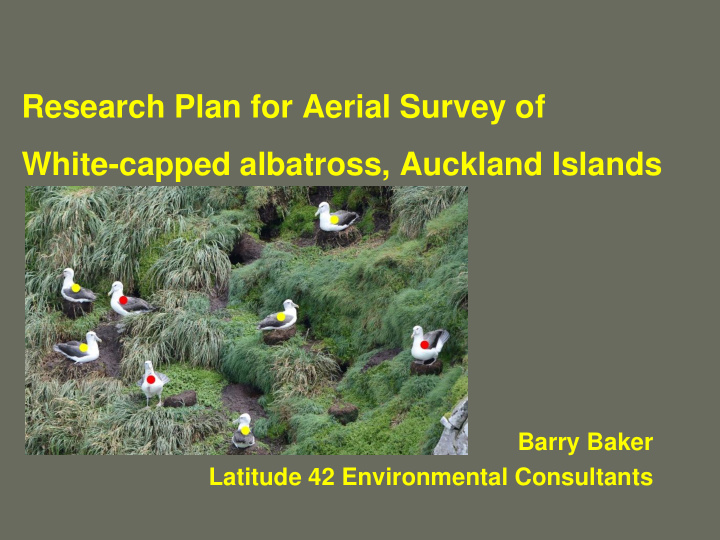



Research Plan for Aerial Survey of White-capped albatross, Auckland Islands Barry Baker Latitude 42 Environmental Consultants
background - WCA ― endemic NZ species ― Auckland Islands Disappointment Island (110 000 pairs) SW Cape (3 000 pairs) Adams Island (100 pairs) ― Antipodes Islands Bollons Island (50-100 pairs) ― regularly interacts with fisheries in NZ and elsewhere 2
white-capped albatross ― annual photographic counts of all WCA colonies in the Auckland Islands 2006 - 2012 ― now propose to undertake another count in January 2015 of all Auckland Is colonies ― analyse photos, count breeding birds, determine popn trend 3
photography WCA ― conduct one photo survey of WCA colonies in Aucklands Is in January 2015 ― aerial platform Squirrel Helicopter ― Nikon digital cameras & image-stabilized lenses ― series of overlapping photos of all colonies (70 - 200 mm) ― photos to be taken as fine-scale jpeg or raw files of minimum 20 MB size 4
3 groups of photos ― overall scenic shots of the colony to assist later when building photomontages of the site ― series of overlapping photos of all areas with nesting birds (70 mm) ― close-up photos to examine proportion of empty nests & non-breeding birds (300mm) ― compare close-up photos with ground count to assess proportions of breeding & non-breeders c. 3,000 photos taken each year, since 2006 with no impact on birds detected 5
Close- up photos 6
counting protocol for WCA ― photomontages constructed using Adobe Photoshop software ― paintbrush tool mark off counted birds 7
data assessment ― all birds on the ground counted. ― each single bird assumed to represent an annual breeding pair. ― close up photos & ground truthing will be used to estimate proportion of birds present but not breeding, so counts can be subsequently adjusted ― all images will be counted by one observer ― repeat counts of randomly selected montages by 2 other observers in previous years has confirmed no evidence of observer bias in counting 8
WCA photographic data storage ― photographs will be submitted to DOC for archiving ― photos will be provided in one directory White-capped albatross 2015 with three sub- directories ― Original photos ― Stitched images ― Counted images ― Two set of photographs also retained by Latitude 42 and stored on and off the office site 9
White-capped albatross at Disappointment Island David Thompson & Paul Sagar Presentation to CSP Technical Working Group, December 2014
White-capped albatross at Disappointment Island, Auckland Islands • Largest population, 95% of breeding pairs • No pigs, cats or mice • Ongoing aerial survey work • ACAP funding received to undertake white-chinned petrel population estimate • virtually nothing known about this species at the Auckland Islands • Kalinka Rexer-Huber PhD, Otago University • field team on island for ca. 8 days • Opportunity to:- • carry out ground-truthing of aerial survey • establish study population
White-capped albatross – Disappointment Island • Conservation status: At Risk – Declining – No conclusive evidence of a decline from aerial surveys • ‘Very High’ risk, L2 Seabird Risk Assessment • Draft CSP 5-year seabird research plan: 2015/15 – review M-R feasibility (Table 4)
Ground-truthing • Temporally-aligned with aerial survey work in January 2015 • Experienced 3-person field team • Each to walk a transect encompassing at least 200 nests within 3m either side of transect (at least 600 nest total) • At time of day of aerial survey • Record: • number of pedestals • actively breeding • on obviously failed nest • on empty nest • loafing
Mark-Recapture Feasibility • Main issue – access to/from island • Burrows • No shortage of nesting birds • No pests • Logistic support • January visits would maximise band re- sights
January 2015 • Establish study population, size only constrained by time, and future time on island for re-sighting • Metal band and large plastic band • Defined study area, topographically and GPS, above
Recommend
More recommend